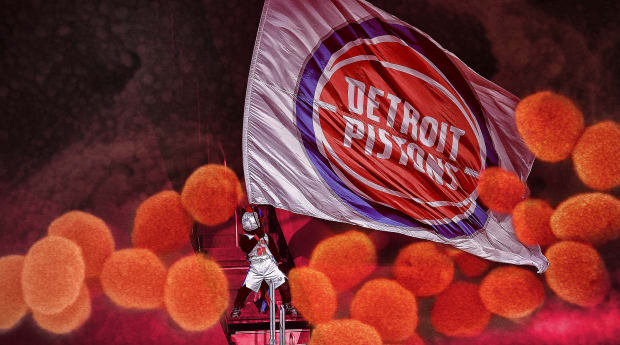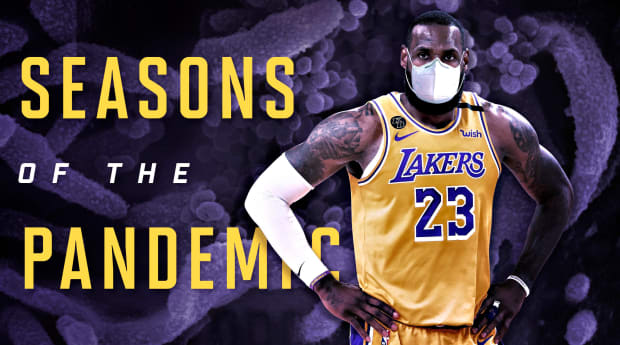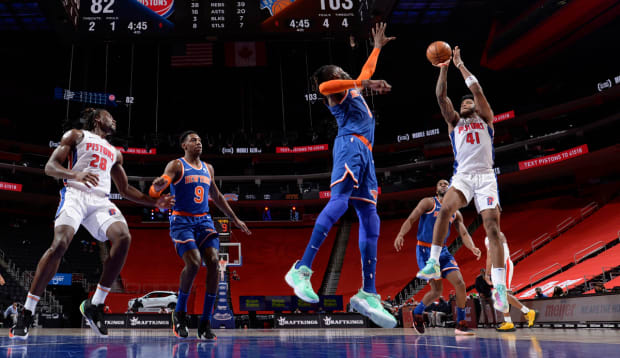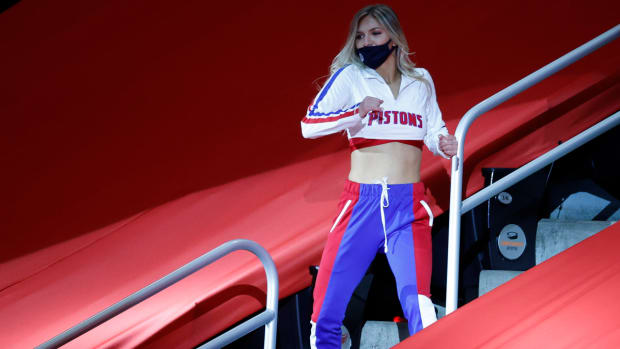The pandemic has impacted virtually every element of staging an event.
John Mason has always been easy to hear. The Pistons’ public address announcer has been stationed courtside at games since 2001, developing into an iconic part of the franchise thanks to his booming voice and constant enthusiasm. As one of Mason’s childhood friends once told him, he has “the gift of gab.”
Mason, though, has always been tough to reach, at least to those not in the arena when he’s on the mic. Before this season, Mason never brought his cellphones into games, instead preferring to lock his Android and iPhone in his car before entering. “What do you need a phone for?” Mason asks. “You’re there to call a game.”
Except for this year. Amid the COVID-19 pandemic, the Pistons have made an effort to limit how often people go near the scorer’s table and pass around various sheets of paper. They are going largely paperless. As a result, Mason brings his iPhone into games to look up opposing team rosters and familiarize himself with numbers and positions. While in past seasons, he would ask visiting assistant coaches for pronunciation help, he now relies primarily on YouTube. “I hate that I have to do it,” he says of no longer being tech-free. “I don’t want to be in my other world. I want to go totally NBA when I’m in there.”

Over the last year, though, that “other world” has forced the NBA to change like never before. Games look, feel and sound different, with adjustments ranging from 99,000 square feet of heavy knit red fabric filling the lower bowl of Detroit’s Little Caesars Arena to a veteran PA announcer being forced to carry his cellphone to his courtside seat. With the league at the one-year anniversary of the night it—and much of society—came to a screeching halt, the Pistons had been one of the 16 teams that did not have ticketed fans heading into the All-Star break. Instead, they have played their home games in front of crowds that top out at around 250 people, all invite-only—and almost all of whom are team employees or player families and friends.
As Mason, wearing a gray Under Armor facemask and matching “D-Up” hat, calls out Detroit’s starting lineup for a Jan. 25 game against the 76ers, dancers perform next to a DJ booth located in Section 115 and at the top of aisles behind the team benches. They are all masked. Even Hooper, the team’s mascot who is waving a team flag a third of the way up from the floor, has a face covering over his muzzle. Strobe lights flicker throughout the arena, darting on and off the tarps that cover almost the entirety of the bowl. When Mason’s player introductions conclude and the lights are raised, players mull around their benches while faint cheers ring in the background. Twenty people look on from socially distanced seats spaced out across the length of the opposite sideline. Behind one of the floor’s baselines is a red Chevy Silverado Trail Boss, parked just a strong chest pass away from the court as part of a promotion.
Adaptations are plenty on this night, in this arena and around the league. “It’s all hands on deck and I personally have not seen it ever at this extent the way it is,” says Pistons director of team operations Mike Abdenour, who is one of the select few sitting courtside.
“Every day in the NBA is like a snowflake. There’s no two the same.”
Especially so this year.

Read More Stories On the Year of the Shutdown
At around 11 a.m. on Jan. 25, Claire Czerniuk arrives at Little Caesars Arena to begin preparing for that night’s game against the 76ers. As Detroit’s director of game presentation, she’s tasked with producing everything entertainment-related that fans would normally witness in person. “It’s a new job,” Czerniuk says. “We’re reinventing everything we’ve done in the past and figuring out ways to adapt it now, especially in the environment where we might have fans back one day in a limited capacity.”
While others in the organization have fond memories of witnessing the Chauncey Billups–led Pistons take home the 2004 NBA title in The Palace of Auburn Hills, Czerniuk is new to the team this year, having recently worked for the Knicks. Last summer, she also spent time in the WNBA bubble in Bradenton, Fla., an experience that is particularly valuable when tackling her current responsibilities.
Before the season, Czerniuk painstakingly broke down every element of a live NBA game. Classic in-person elements such as a T-shirt toss had to be modified. So, too, did the national anthem and halftime performances. On this night, country singer Rocky Wallace, a Detroit native, performs the “The Star-Spangled Banner.” It was taped weeks earlier, much like the Pistons Drumline performance, which airs on the jumbotron between the first and second quarters. “You’re always trying to create a home court advantage and some sense of normalcy for the players in this bubble environment,” Czerniuk says.
Throughout the day, Czerniuk meets with various members of the Pistons’ game entertainment staff to go over the script for that evening. At 7:03 p.m. sharp, a horn blares throughout the mostly empty arena, marking the official start of her team’s show and signaling that tipoff is just five minutes away. Czerniuk has long been in her seat, which is just to Mason’s right. Wearing a black headset, she queues up elements every 15 to 30 seconds from the show’s opening until the end of the game. A decibel meter is in front of her, assessing the noise level in the arena. In the team’s current environment, the Pistons never want it to go above 80 dB, roughly comparable to a food blender or garbage disposal and also the same level of a typical NBA game from years past, though, a raucous crowd can raise that number substantially.
Across the league, the loudness of different arenas varies. On a number of topics this season, including sound, the NBA has provided teams with a framework to follow as well as a list of best practices. But the league also built in enough flexibility so that teams could be creative. The Pistons, who share their home arena with the NHL’s Red Wings, installed clusters of speakers near each of the court’s four corners. Two audio sweeteners, one of which is their team DJ, manage a library that consists of more than 1,000 sounds and reactions.
“To me, the arena doesn’t really feel that quiet because they still have all the noise,” says Pistons rookie center Isaiah Stewart. “But for guys who have been in the league a bunch of years, it’s different for them.”
Stewart, one of the team’s three first-round picks in the 2020 NBA draft, opens the game on the bench, which, new to this season, has a video board in front of it. The screen—and the one in front of the visiting Sixers’ bench—marks one of the smaller visual changes courtside. They also represent a new way in which organizations have sought to promote their partners during gameplay.
“COVID changed everything for us,” Leah Emmons, the Pistons’ vice president of partnership engagement, says of how her team has re-thought business collaborations. “Basketball is about people in the arena and the excitement that builds and the experience that we’re able to create for our fans throughout our partnerships. [The virus] just changed everything.”
Emmons, now in her eighth season with the team, is in charge of activating team sponsorships. She says that due to the fanless environment, they’ve transitioned a lot of partner activation digitally, such as conducting a Spin-to-Win game on Pistons.com and mailing a prize to the victor’s house. “We’ve done a bunch of contesting on social that we didn’t do before so fans stay engaged and still feel like they’re part of those promotions,” Emmons says.
Despite the team’s struggles—Detroit was just 10–26 at the All-Star break—Emmons says that fan interest has remained high. The Pistons’ on-court effort has also never been questioned, and on this night they lead 34–23 after the first quarter. During a stop in the action with just over 7:30 to go in the second, a “dance cam” graphic airs on the Jumbotron, much to delight of the two-hundred-plus masked spectators in attendance. Mason gets a chance to charm the limited crowd.
Before this season, he had tried on eight different masks, both to see what was comfortable to wear at games and also allow him to be heard clearly. In this altered environment, the man known for his thunderous “DEEEEE-TROIT BASKETBALL” chant tries to strike a balance between “delivering the hype” and “doing it in an understandable way,” not wanting to overpower the atmosphere.
“I’ve become like the music in your car,” he says. “For fans watching it on TV, they just need to hear that music.”

Few, if any, in Detroit’s organization have heard the sound of roaring Pistons crowds as much as Abdenour, the team’s director of operations. In 1975, he was hired as a trainer and he has subsequently worked 42 of the last 45 years with the franchise, taking just a three-year hiatus between 1992 and ’95 to join the 76ers. In 2014, Abdenour took on his current role, which involves overseeing the team’s logistics and travel operations. This season, he says it’s especially difficult to plan because “everything is in a constant state of flux.”
Abdenour is courtside as the Pistons race out to a double-digit halftime lead over Philadelphia, and he watches them maintain the edge early in the third quarter. But unlike some others who are seated on the floor’s perimeter, he spent the duration of the day at the team’s practice facility, which is around three miles away, ironing out the upcoming trip to Cleveland.
Travel parties around the league are smaller this season. On each road trip, just 45 members of the Pistons organization attend, plus up to three additional people who are a combination of COVID-19 testers and compliance officers. Eating is no longer allowed on team flights shorter than three hours, and four buses are needed for ground transport compared to two last year. Throughout the afternoon, Abdenour made adjustments to Detroit’s travel manifest, modifying who from the organization was traveling on the plane and calling the hotel to ensure that it had enough rooms allocated. He finalized the Pistons’ transportation and had to reschedule the team’s practice time. “I’m not taping ankles anymore, but I’m just doing a million other things to keep the bus moving,” he says.
Abdenour says he’s proud of the organization’s inter-department collaboration and its ability to adapt to various challenges. But he also acknowledges the mental stress that having limited personal interactions with colleagues can have.
Others around the league appear to have similar concerns amid the heightened precautions. In January, an ESPN report noted that some team officials tasked with enforcing and managing the league’s day-to-day health and safety protocols have struggled to balance their new responsibilities with their typical team duties. A February report from The Ringer keyed in on trainers, and how their jobs have been all-consuming this season. “To be perfectly honest, most of us have worked since fall nonstop,” one NBA trainer told the publication.
Abdenour applauds the work of Detroit’s support and training staff, but says that “trying to accommodate the COVID-19 protocols and having that dance with the basketball itself and still having a positive outcome, that’s been a challenge for everybody.”
Unlike some organizations around the NBA, the Pistons, up to this point, have avoided a COVID-19 outbreak. Still, schedule changes have felt almost inevitable for everyone. The team’s Jan. 13 game against the Wizards was postponed due to contact tracing within Washington’s organization. Weeks later on Feb. 1, Detroit players were about to take the floor for layup lines in Denver when they learned of an inconclusive test result that eventually caused that night’s contest with the Nuggets to be moved.
In mid-February, a game against San Antonio was postponed due to a positive result within the Spurs. And the schedule roulette also saw Detroit’s road matchup with the Mavericks postponed due to severe weather. (The Pistons were promptly scheduled to play a road matchup with the Bulls on the same date after Chicago’s prior opponent was unavailable to play due to contact tracing.)
An early March game against the Raptors was also postponed due to an outbreak within the Toronto organization.
“Making a change is not like stopping your car and making a right-hand turn on red,” Abdenour says. “This is like stopping an aircraft carrier and doing a 180 because you’ve just made a change. And the amount of people that are involved in that change is mind-boggling.”

During a break in the action with 5:09 to play in the game and the Pistons leading 104–90, a “mask fashion cam” graphic appears on the Jumbotron. With peppy music playing in the background, a camera cuts from one of the few invite-only spectators to another and then to another, all of whom are dancing in their seats while, crucial to the bit, wearing their face masks. “Money green,” Mason says when one man is projected onto the screen. “Piston red,” he says of another. “Kid friendly,” he shouts, referring to a child wearing a Buzz Lightyear–patterned face covering.
The bit is part of a series of new elements that have undergone a trial run while the Pistons have had limited attendance. Among other subtle adaptations to prepare for future crowds, Detroit has started using QR codes to promote specialty merchandise, hoping to encourage fans to purchase products by remaining in their seats and not rush to the team shop. On this night, DJ Prevu takes fan song requests through Twitter to put together his halftime set, testing out another means to engage seated crowds when ticketed spectators do return. An air-hug cam and blow-a-kiss cam have also been implemented in recent weeks to try and eventually balance spectator enjoyment with safety measures.
“When the fans are there, it will be that much more exciting for them and we’ll be ahead of the game,” says Natalie Miramontes, the Pistons’ dance team coach.
Another component the team has prepared for is how to handle modified live performances. Throughout the season’s first half, Detroit had been one of just three teams to have in-person dancers, but not fans. This fall, Miramontes held both virtual prep classes and auditions, which allowed a wider breadth of candidates to apply for the role. One member of the Pistons’ dance team moved to Detroit from Japan. Another moved from California.
On game nights, the dancers perform in designated areas around the lower bowl, doing so for the few hundred people in attendance and to help enrich the TV broadcast. On-court performances are pre-taped, with one shoot day consisting of more than a half-dozen routines. “We might be fanless, but we’re getting more exposure now,” Miramontes says. “We’re building as much as we can for when fans come in.”
The organization is hoping that such preparations pay off.
Around the league teams have been at different places in welcoming fans back into arenas. Just before the All-Star break, the Knicks and Nets became the two latest teams to have ticketed fans, allowing up to 10% attendance each. Other teams, like the Magic, Jazz, Pacers and Rockets are allowing the highest capacity at more than 20% each.
On March 3, the Pistons announced their plans to begin selling tickets for upcoming home games, starting with up to 750 fans attending their March 17 contest against the Raptors. All guests entering will be required to complete a health survey screening. Other adjustments range from the installation of mobile ticket scanning pedestals to the disabling and covering of drinking fountains. The Sixers, Celtics, Hornets, Raptors and Spurs will also welcome back fans early in the second half of the season.
As crowds increase, the amount of tarp rolled out diminishes. “I think it will be different than it was before, no matter what happens,” Emmons says.
In this regard, NBA teams are wrestling with many of the same challenges that others in society are weighing. Who knows whether, and when, things will ever return to normal.
“I hope that it will eventually get back there,” Emmons says, “that Hooper will be hugging our fans and that we’re able to get back to that. But if not, we’ll continue to think of unique ways to be involved in the community and be involved with our partners that makes people comfortable and continues to bring people together.”
When the final buzzer sounds in Detroit’s 119–104 win over the 76ers, the game’s two head coaches, Dwane Casey and Doc Rivers, share a brief embrace at midcourt before returning to their respective locker rooms. (It has to be brief as the NBA tightened postgame on-court interaction restrictions in January). Pistons guard Delon Wright, who scored a game-high 28 points, walks over to the basket stanchion nearest to the home team’s bench and puts on a headset that had been sanitized and bagged pregame in advance of a postgame interview.
Mason then reminds the few spectators in attendance to socially distance as they exit Little Caesars Arena and encourages them to travel home safely. Less than five minutes after the final buzzer, the stadium bowl is almost completely empty.
Mason grabs his red notebook off the scorer’s table, puts his phone in his pocket and heads toward his car. He will return to Little Caesars Arena the next day, however, even though the team is on the road. He needs to take a COVID-19 test in advance of games later that week.
Such is the norm in this all-hands-on-deck season.